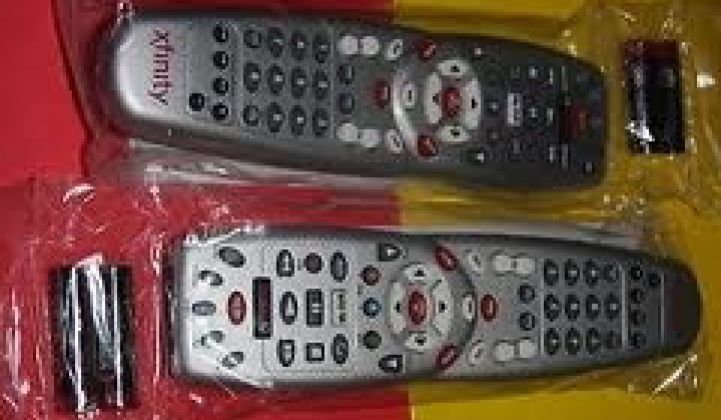Maybe the cable company will run your home energy network.
GreenPeak certainly thinks so. The Dutch semiconductor manufacturer makes low-power wireless ZigBee chipsets for networked building devices, including, since January, remote controls for Comcast’s Xfinity TV service. Most of GreenPeak’s business is in this super low-power communications category, and very little is focused on energy devices.
But in terms of connecting homes to smart meters, smart thermostats and other energy-sensing (and controlling) devices, it could be a bigger deal down the road, GreenPeak CEO Cees Links said in a May interview. That’s because the same chips doing the remote control can also be set to control all those smart energy devices, as well as connect to smartphones, iPads and other internet-connected devices.
Comcast, like rivals AT&T, Verizon, and its competitors overseas, has been pushing triple-play -- phone, cable and internet -- service for years now. But there’s a fourth play in its game plan, falling under the general term of home monitoring and automation. That’s everything from security cameras and remote door locks to sensors that tell you whether you’ve left the lights or appliances on in different parts of the house.
Weren’t smart meters supposed to do all of this? Well, it turns out that utilities have dawdled on hooking up their smart meters for in-home connectivity. Even where they have, few customers appear to want it. For example, Texas utility CenterPoint Energy has turned on smart-meter-to-home ZigBee connections for all its 2 million or so Houston-area smart meters, but according to meter vendor Itron, only about 6,000 in-home devices have been hooked up so far.
“One or two years ago, it looked like it as going to be a battle between utilities and the [telco and cable] operators” on the home energy front, Links said. “But frankly, nowadays, the operators already have the infrastructure in place to distribute data to the home,” mainly broadband internet. Once that’s in place, it doesn’t matter whether it was built to lock doors, turn TVs on and off, or any other function -- it can also talk to energy-aware devices.
We’re seeing more interest in the home automation front from telecommunications giants. AT&T launched its Digital Life home automation platform in May, and Verizon launched its service in October to its nearly 5 million U.S. FiOS broadband internet customers. (No word since the launch how many customers have signed up.)
Both companies have chosen Z-Wave, a competing low-power wireless standard, for their deployments. Links would obviously like to see ZigBee, rather than Z-Wave or another low-power wireless technology, take the lead in home automation deployments, which number in the millions, mostly in Europe. Startups like Control4 are using ZigBee to connect high-end home entertainment systems, and some energy controls.
Then, of course, you’ve got Wi-Fi to carry rich content like audio/video and the like, Links said. “In our view, Wi-Fi will be the content distribution network, and ZigBee will be the sensor control distribution network in the home,” he said.
But for now, “We have to take this in stages,” he said. “The first stage is migrating the set-top box to a home control module. The next step is to offer customers subscriptions to services,” which can include home security, home connectivity, or home energy efficiency, he said.
Indeed, where utilities may see the home area network (HAN) as chiefly an energy management system, telcos see energy as a value-add to get more customers to sign on to the core service.
Take EcoFactor, the cloud-based self-optimizing home HVAC startup, which was named a Comcast home automation partner in February. Its cloud-based software will manage no-touch, HVAC optimizing thermostats, to be sure. But it will come alongside a host of cameras, carbon monoxide and flood sensors, and other home automation gear from Comcast's service, powered by startup iControl.
Startups like iControl and AlertMe, have also aimed at home automation and security as a channel to market, with energy savings as an added bonus. That’s important, because it’s unclear whether most homeowners are willing to spend any money at all, or even pay attention to, how much energy they use.
Still, some early pilots from the likes of Opower, Simple Energy, Tendril, Silver Spring Networks and Energate have shown the potential for savings in the double-digit percentage ranges when people have both energy insight and devices to automate responses.
Utilities have another problem in justifying the cost of in-home technology -- fairness. Elderly and low-income ratepayers can’t be charged, via rate increases, for something they don’t get to take part in. Utilities will have trouble spending money to connect smart meters to home efficiency unless they offer some sort of alternative for their least well-off customers -- perhaps free, simple energy displays, or rebates to purchase smart thermostats.
In the meantime, a host of retail channel partnerships are testing the mass market for home energy efficiency. British startup AlertMe is selling its networked home devices through Lowe’s home improvement chain, as well as via partnerships with utility British Gas. Honeywell also announced its own cloud platform for its smart thermostats last year, and has partnered with energy efficiency startup Opower for a smart thermostat combo, set to debut later this year. Nest, the sleek smart thermostat startup founded by Apple alums, sells its devices online via Amazon and Apple.



